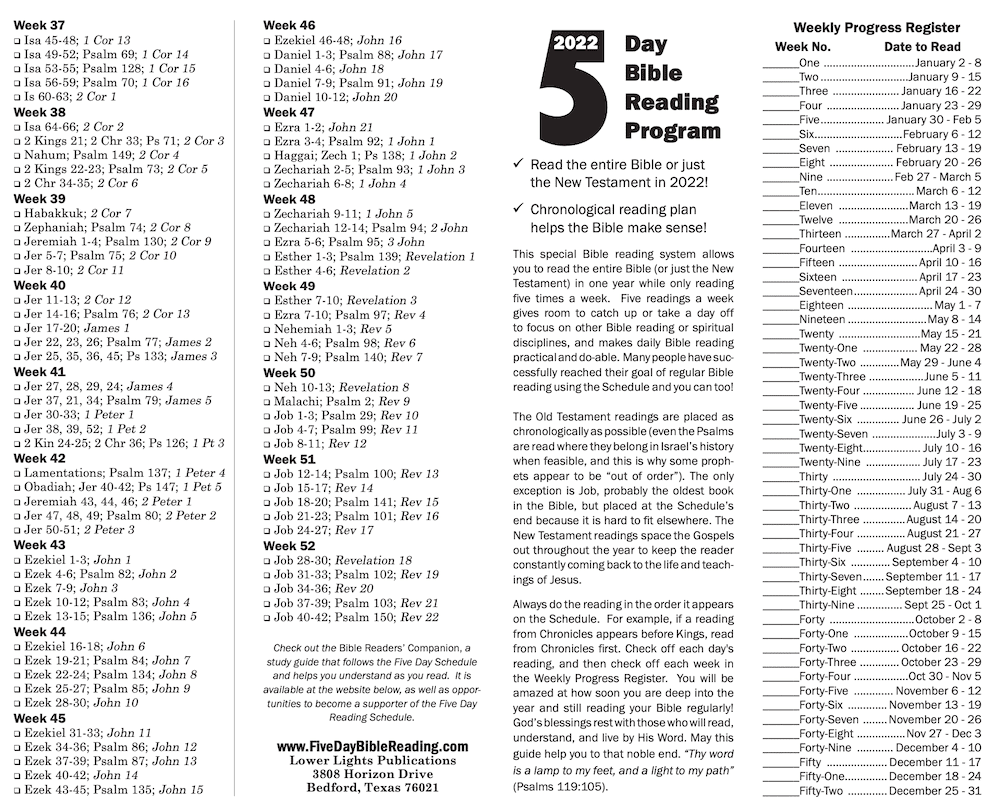 A new year offers a new opportunity—an opportunity to rethink and refresh the way you read your Bible. While some have found a pattern or habit they love and will never deviate from, others like to look for new ways to read, digest, and apply the Word. For those who may be interested in trying something new, here are a few ideas that may be worth considering.]]>
A new year offers a new opportunity—an opportunity to rethink and refresh the way you read your Bible. While some have found a pattern or habit they love and will never deviate from, others like to look for new ways to read, digest, and apply the Word. For those who may be interested in trying something new, here are a few ideas that may be worth considering.]]>
A new year offers a new opportunity—an opportunity to rethink and refresh the way you read your Bible. While some have found a pattern or habit they love and will never deviate from, others like to look for new ways to read, digest, and apply the Word. For those who may be interested in trying something new, here are a few ideas that may be worth considering.
Create An Heirloom
Paul Carter describes a great way to turn a retired Bible (or a brand new Bible, for that) into a precious family heirloom. This is a project that will probably take a couple of years but will result in something precious and meaningful. You can learn more about Paul’s method here.
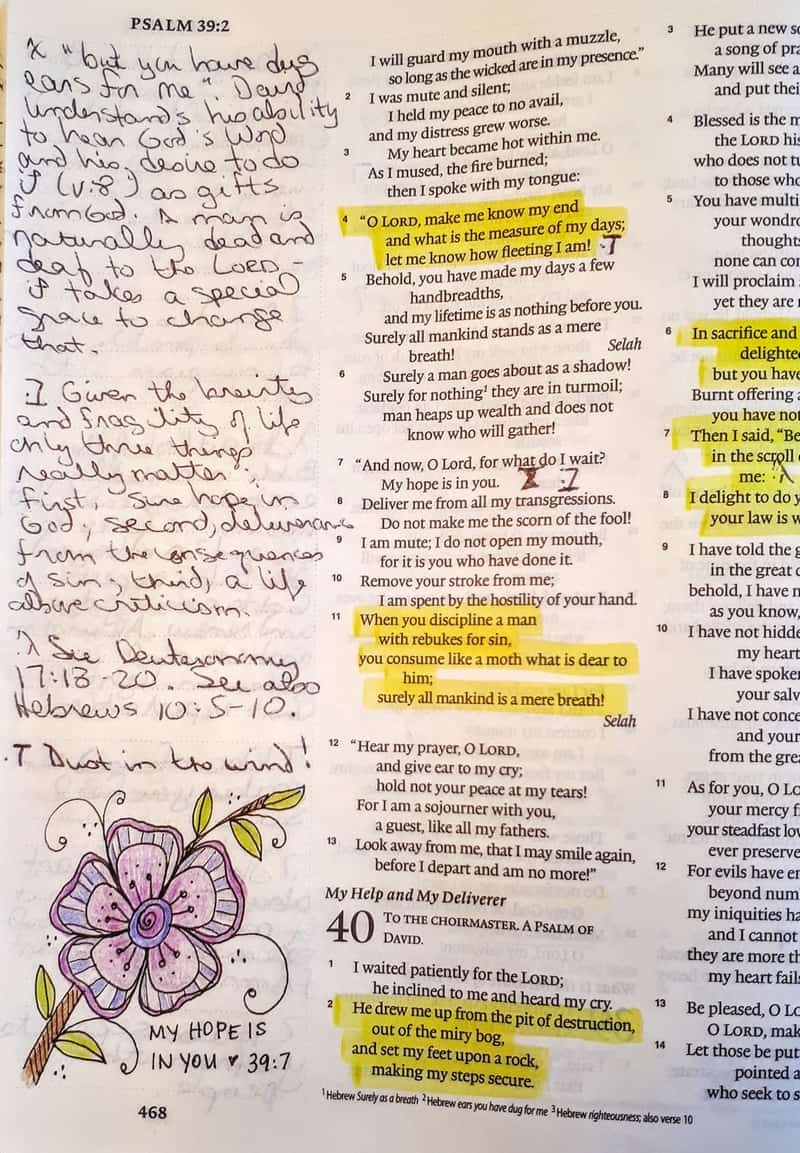
Read It In a Year
I have long been an advocate of the 5-Day Plan that takes you through the entire Bible in a year. It does so chronologically with five readings per week drawn from both the Old and New Testaments. This plan has led me to read the Bible repeatedly and I have benefited a lot from doing so. You can learn more about the program here.
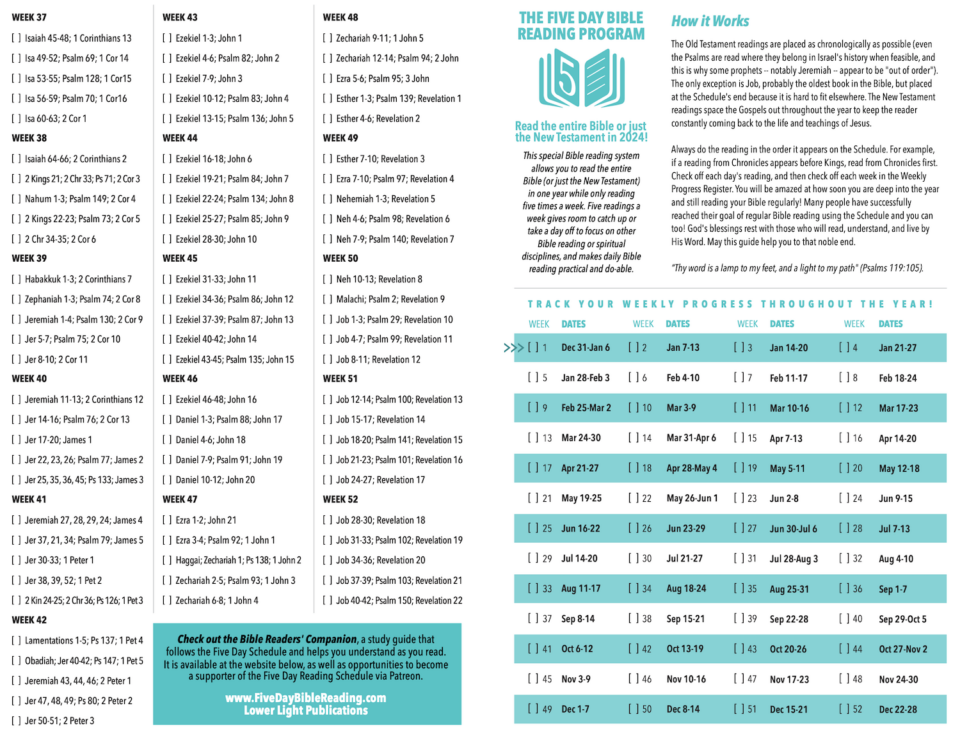
Write It Out
Rebekah is an advocate of writing out the Bible—taking the time and putting in the discipline to write it out by hand. She describes her method and tools here. This method helps you slow down and think while also potentially engaging your artistic side. You can see some photos here.
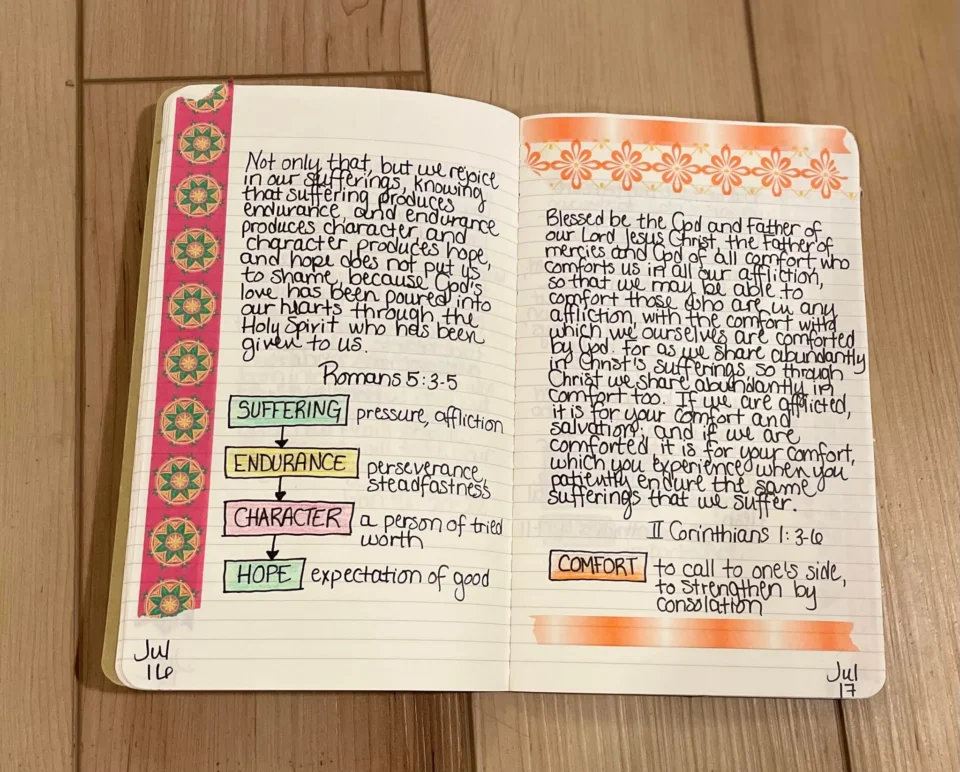
Use the “God’s Word for You” Series
The “God’s Word for You” series from The Good Book Company is an excellent collection of resources that will take you deep into many of the books of the Bible. The volumes are written by well-known Bible teachers like Tim Keller, Tim Chester, David Helm, Al Mohler, and so on. There are enough of them now (35 volumes, I believe!) that you could make this a multi-year project. You can find the set here. If you’d like to make this a family or group project, you can get the Good Book Guides which nicely supplement them. (Note: The Philippians volume was written by Steve Lawson, so you may want to take a pass on that one.)
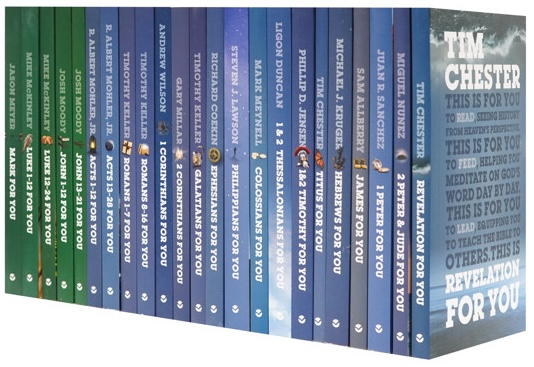
Use a Reader’s Bible
A reader’s Bible is the same text as any other Bible, but without the chapter and verse markings (which, as I’m sure you know, are not actually part of the inspired text). This allows you to read the Bible more as it was meant to be read, without having the flow interrupted by divisions that are sometimes helpful and sometimes not. You’ll find lots of options in the ESV and other translations.

Follow Tabletalk Magazine
Ligonier Ministry’s Tabletalk magazine has long offered daily Bible studies that combine with a Bible-reading plan and other thematic articles. I know many people who have used this for years as a mainstay of their personal devotions. You can learn more and sign up for a free three-month, no obligation, no credit card trial of the magazine at tabletalkmagazine.com.

Use an ESV Reading Plan
You may enjoy exploring the various reading plans that come with an ESV subscription (which is priced very reasonably for what you get). Some will take you through the Bible in a year while others will focus on various themes. Still others will depend on books Crossway has published such as Dane Ortlund’s In the Lord I Take Refuge. You’ll also gain access to lots of study Bibles, commentaries, and other great resources. You can learn more at ESV.org.

Try Professor Horner’s System
Professor Horner’s system is an intense one! His program involves reading ten chapters per day from ten different books of the Bible, all year long. The idea is that the different readings begin to overlap in different ways, increasing your knowledge not only of Scripture but also of its cohesion. I haven’t been able to find an official page for the plan, but this article from my archives has what you need to know.

Read It in 90 Days
Every year Knowable Word advocates beginning the year by reading the whole Bible as quickly as you feasibly can while still gaining benefit from it—in 90 days or less. They are even having a challenge this year that includes a giveaway for those who participate and complete the Bible before March 31. You can learn more here.
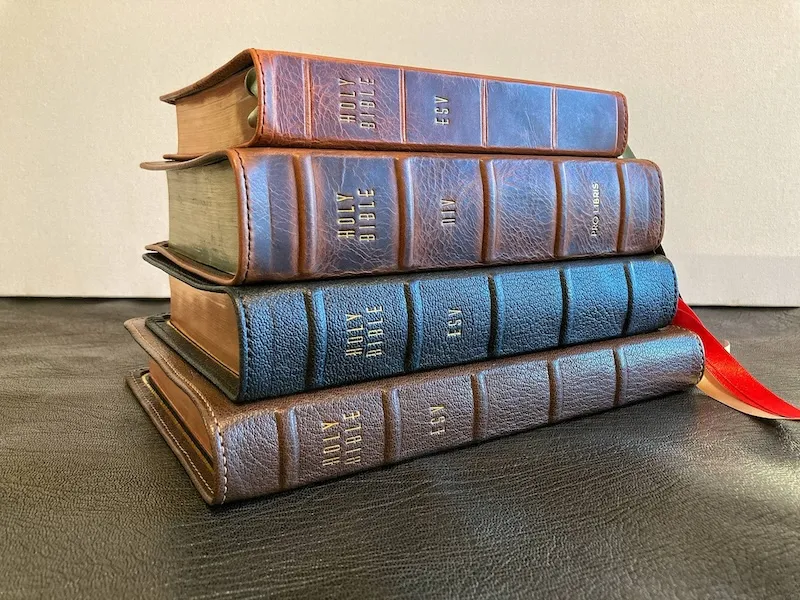
Eat the Bible
Nate Pickowicz advocates a plan that I believe was first popularized by John MacArthur. The idea is to read individual books of the Bible repeatedly until you have grasped both their big picture and their fine details. You can find more about plans like this online or buy Nate’s book How To Eat Your Bible which includes a 7-year plan to use this method until you have completed the entire Bible.

Journal Your Way Through
In the last few years we have seen the rise and popularization of the journaling Bible—a Bible that has blank lines in the margin where you can write your own notes. I tend to read the ESV and it has lots of options such as paperback (currently deeply discounted), illuminated and the new Spiral-Bound Journaling Bible. Plus, of course, there are lots of one-volume editions.

Generate Your Own Plan
The Bible Reading Plan Generator will let you custom-craft a Bible-reading plan that helps you achieve whatever kind of plan you would like to follow this year.

 Many Christians experience a contradiction between what we believe to be true about the Bible and our actual practice of reading the Bible. Often our theology is superior to our habits. We profess that the Bible is infallible, inerrant, authoritative, and sufficient, but we then neglect it in our daily lives. We agree with David when he says of God's words, "More to be desired are they than gold, even much fine gold; sweeter also than honey and drippings of the honeycomb" (Psalm 19:10). Yet in our lives we show little hunger for those good, pure, sweet, nourishing words.]]>
Many Christians experience a contradiction between what we believe to be true about the Bible and our actual practice of reading the Bible. Often our theology is superior to our habits. We profess that the Bible is infallible, inerrant, authoritative, and sufficient, but we then neglect it in our daily lives. We agree with David when he says of God's words, "More to be desired are they than gold, even much fine gold; sweeter also than honey and drippings of the honeycomb" (Psalm 19:10). Yet in our lives we show little hunger for those good, pure, sweet, nourishing words.]]>
Many Christians experience a contradiction between what we believe to be true about the Bible and our actual practice of reading the Bible. Often our theology is superior to our habits. We profess that the Bible is infallible, inerrant, authoritative, and sufficient, but we then neglect it in our daily lives. We agree with David when he says of God’s words, “More to be desired are they than gold, even much fine gold; sweeter also than honey and drippings of the honeycomb” (Psalm 19:10). Yet in our lives we show little hunger for those good, pure, sweet, nourishing words.
How can this be? It is because we allow other things to take the place that should be reserved for God and his Word. It is not that we lack time, but that we lack desire. It is not that we lack ability, but that we lack interest. Robert Chapman says it this way: “The great cause of neglecting the Scriptures is not want of time, but want of heart, some idol taking the place of Christ.”
I think each of us can agree and admit that we too often permit the presence of some idol, something that displaces in our lives the place of prominence that only God deserves. Whether it is entertainment, work, socializing, or something else altogether, we will not prioritize God until we uproot that idol.
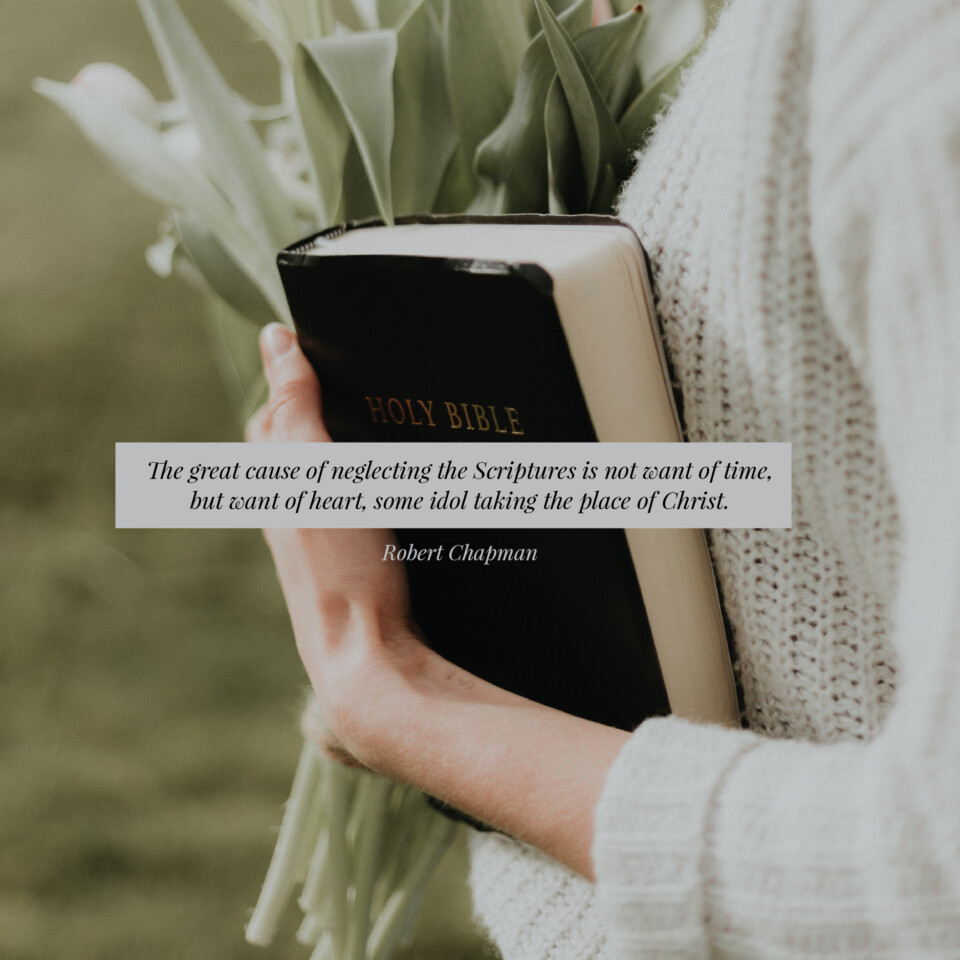
 Motives matter, even (or perhaps especially) when it comes to something as very good as studying the Bible. The best motive for reading the Bible is to be transformed by it. For this to happen, we must approach our reading and studying with both confidence and humility, asking God to transform us through his Word. Many skeptics read the Bible for a very different purpose—so they can attack it or undermine it, so they can disprove it or mock it. They prove that great knowledge of the Bible may actually lead them farther from God, all because their motives have been wrong. But even Christians can read the Bible for ignoble purposes, perhaps so they can content themselves that they have more knowledge of it than someone else, or perhaps so they can feel like they have crossed off that box on their daily list of tasks. Martyn Lloyd-Jones once said, “It is a good thing to be a student of the Word, but only in order to be a practiser and experiencer of the Word.” He reminds us that our efforts in the Word should always be leading toward wisdom, which is living a life that is fully pleasing to God. It is good to be a student of the Bible, but only if we are studying for the right reason—to practice and experience it in our daily lives.]]>
Motives matter, even (or perhaps especially) when it comes to something as very good as studying the Bible. The best motive for reading the Bible is to be transformed by it. For this to happen, we must approach our reading and studying with both confidence and humility, asking God to transform us through his Word. Many skeptics read the Bible for a very different purpose—so they can attack it or undermine it, so they can disprove it or mock it. They prove that great knowledge of the Bible may actually lead them farther from God, all because their motives have been wrong. But even Christians can read the Bible for ignoble purposes, perhaps so they can content themselves that they have more knowledge of it than someone else, or perhaps so they can feel like they have crossed off that box on their daily list of tasks. Martyn Lloyd-Jones once said, “It is a good thing to be a student of the Word, but only in order to be a practiser and experiencer of the Word.” He reminds us that our efforts in the Word should always be leading toward wisdom, which is living a life that is fully pleasing to God. It is good to be a student of the Bible, but only if we are studying for the right reason—to practice and experience it in our daily lives.]]>
Motives matter, even (or perhaps especially) when it comes to something as very good as studying the Bible. The best motive for reading the Bible is to be transformed by it. For this to happen, we must approach our reading and studying with both confidence and humility, asking God to transform us through his Word.
Many skeptics read the Bible for a very different purpose—so they can attack it or undermine it, so they can disprove it or mock it. They prove that great knowledge of the Bible may actually lead them farther from God, all because their motives have been wrong.
But even Christians can read the Bible for ignoble purposes, perhaps so they can content themselves that they have more knowledge of it than someone else, or perhaps so they can feel like they have crossed off that box on their daily list of tasks. Martyn Lloyd-Jones once said, “It is a good thing to be a student of the Word, but only in order to be a practiser and experiencer of the Word.” He reminds us that our efforts in the Word should always be leading toward wisdom, which is living a life that is fully pleasing to God. It is good to be a student of the Bible, but only if we are studying for the right reason—to practice and experience it in our daily lives.

 Meditation is the activity of calling to mind, and thinking over, and dwelling on, and applying to oneself, the various things that one knows about the works and ways and purposes and promises of God. Thus, to meditate in this way is to call to mind the great truths God reveals about himself—his works and ways and purposes and promises]]>
Meditation is the activity of calling to mind, and thinking over, and dwelling on, and applying to oneself, the various things that one knows about the works and ways and purposes and promises of God. Thus, to meditate in this way is to call to mind the great truths God reveals about himself—his works and ways and purposes and promises]]>
Thomas Watson once warned that “the reason we come away so cold from reading the Word is because we do not warm ourselves at the fire of meditation.” So what is this meditation that he deems so important?
It is crucial we distinguish it from a fraudulent form that is increasingly popular today. Christians are not to engage in the meditation of Eastern religions that involves emptying the mind that it may be filled with a kind of self-knowledge. Rather, the meditation the Bible commends involves filling the mind to achieve knowledge of God. It is the meditation of Psalm 1:1-2: “Blessed is the man who walks not in the counsel of the wicked, nor stands in the way of sinners, nor sits in the seat of scoffers; but his delight is in the law of the LORD, and on his law he meditates day and night.”
Packer says, “Meditation is the activity of calling to mind, and thinking over, and dwelling on, and applying to oneself, the various things that one knows about the works and ways and purposes and promises of God.” Thus, to meditate in this way is to call to mind the great truths God reveals about himself—his works and ways and purposes and promises—and then to think about them, to ponder them, to prayerfully consider them, to allow the mind to dwell on them. Just as heat sets the soft clay to become hard bricks, meditation fixes the truths of Scripture within our hearts, our minds, our lives.

 Hank Williams recorded an old song called "Dust on the Bible." It's a song of lament in which he has gone to a friend's home and asked to see their Bible. When they bring it to him, he realizes it has obviously not been read for a very long time, for it is covered in dust.]]>
Hank Williams recorded an old song called "Dust on the Bible." It's a song of lament in which he has gone to a friend's home and asked to see their Bible. When they bring it to him, he realizes it has obviously not been read for a very long time, for it is covered in dust.]]>
Hank Williams recorded an old song called “Dust on the Bible.” It’s a song of lament in which he has gone to a friend’s home and asked to see their Bible. When they bring it to him, he realizes it has obviously not been read for a very long time, for it is covered in dust.
Oh, you can read your magazines of love and tragic things
But not one word of Bible verse, not a Scripture do you know
When it is the very truth and its contents good for you
But if dust is covered o’er it
It is sure to doom your soul.
Perhaps Williams had encountered this quote by Charles Spurgeon, who wants us to consider that there is a terrible disconnect between a profession of Christian faith and an apathetic disposition toward the Bible. “If you find a professing Christian indifferent to his Bible, you may be sure that the very dust upon its cover will rise up in judgment against him.”
While we may all go through lulls when for a time we drift from our commitment to the Bible, the true Christian will always return to it, for to neglect it is to imperil our very lives. It is food for our souls, it is light for our eyes, it is enlightenment for our hearts. We cannot live and we cannot thrive without it.
(FYI, I’ve always been partial to this version of “Dust on the Bible” by Lost Dogs.)

 Though this omniscient, eternal, and holy God has given us his writings, and though through the Bible he has revealed the way we can be saved, few take the time to give it a fair reading, and few bother to read it all the way through. Christian, receive this book as a gift and commit yourself to reading its broad story and its fine details, for both tell the story of God's amazing grace.]]>
Though this omniscient, eternal, and holy God has given us his writings, and though through the Bible he has revealed the way we can be saved, few take the time to give it a fair reading, and few bother to read it all the way through. Christian, receive this book as a gift and commit yourself to reading its broad story and its fine details, for both tell the story of God's amazing grace.]]>
Perhaps the most remarkable characteristic of our God is his willingness to condescend to us. Out of love for his people he will bestow the most unexpected gifts and take the most unexpected actions—even ones that seem far below the dignity of a God who is “holy, holy, holy” (Isaiah 6:3; Revelation 4:8).
We see this most notably in the willingness of Jesus to take on human flesh and then to humble himself “by becoming obedient to the point of death, even death on a cross” (Philippians 2:8). But we see it as well in God’s willingness to become an author, to give us this record of his acts and his deeds, his purposes and his promises. Whitefield once marveled at both this fact and our response to it: “God has condescended to become an author, and yet people will not read his writings. There are very few that ever gave this Book of God, the grand charter of salvation, one fair reading through.”
Though this omniscient, eternal, and holy God has given us his writings, and though through the Bible he has revealed the way we can be saved, few take the time to give it a fair reading, and few bother to read it all the way through. Christian, receive this book as a gift and commit yourself to reading its broad story and its fine details, for both tell the story of God’s amazing grace.
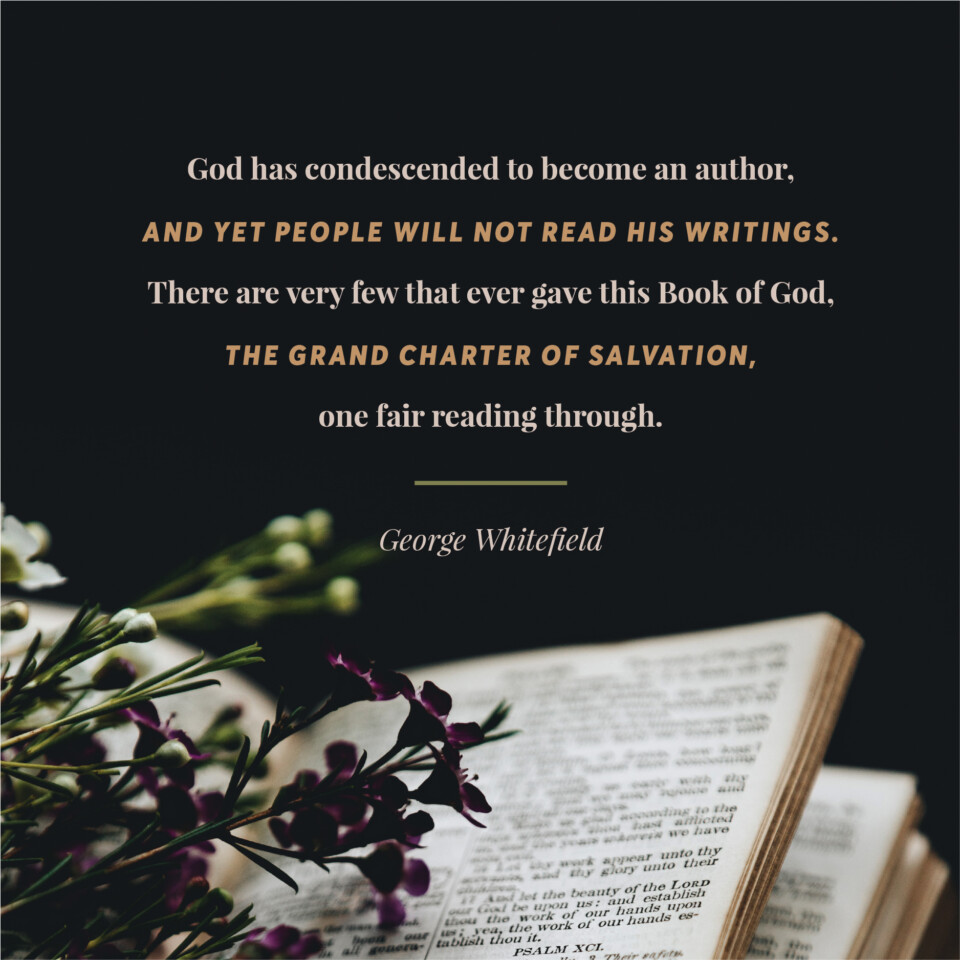
 Tozer once said that "an honest man with an open Bible and a pad and pencil is sure to find out what is wrong with him very quickly," and Psalm 19 provides a clear example from the life of David. His closing words are a prayer for each of us…]]>
Tozer once said that "an honest man with an open Bible and a pad and pencil is sure to find out what is wrong with him very quickly," and Psalm 19 provides a clear example from the life of David. His closing words are a prayer for each of us…]]>
In Psalm 19, David describes God’s “two books” —the book of nature, through which God is speaking of his existence, power, and glory, and the book of Scripture, through which he provides much more extensive knowledge of his works and ways.
David was committed to making a close study of both of these forms of revelation and kept a “pad and pencil” at hand so he could reflect on them. The words he jotted down became the words of this wonderful psalm. His close study of God’s revelation led to the concluding verses, where David prays that God will show him his sins and faults, that God would motivate him to live a blameless and innocent life.
Tozer once said that “an honest man with an open Bible and a pad and pencil is sure to find out what is wrong with him very quickly,” and Psalm 19 provides a clear example from the life of David. His closing words are a prayer for each of us: “Let the words of my mouth and the meditation of my heart be acceptable in your sight, O LoRD, my rock and my redeemer” (Psalm 19:14).
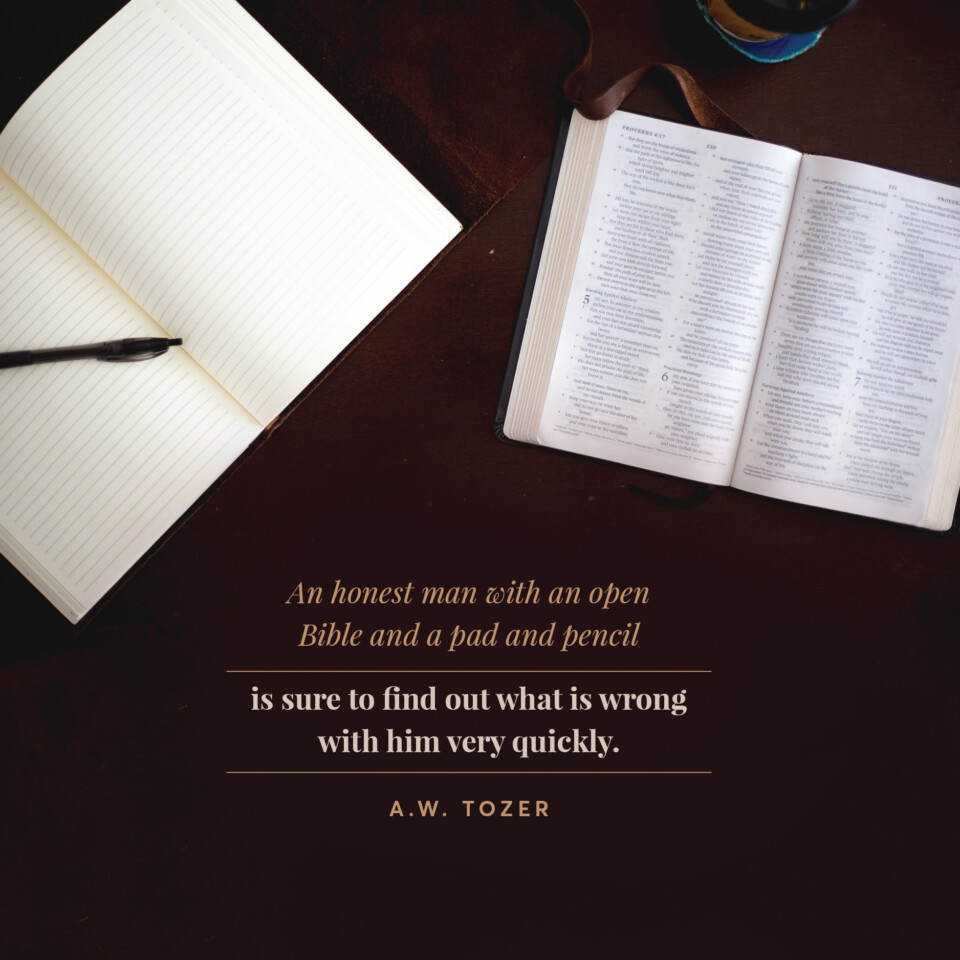
 Nowhere does the Bible command a daily "quiet time." Yet often does the Bible commend an earnest commitment to reading the Bible, meditating upon it, and diligently applying its truths. Often does it commend those who lived according to it.]]>
Nowhere does the Bible command a daily "quiet time." Yet often does the Bible commend an earnest commitment to reading the Bible, meditating upon it, and diligently applying its truths. Often does it commend those who lived according to it.]]>
Nowhere does the Bible command a daily “quiet time.” Yet often does the Bible commend an earnest commitment to reading the Bible, meditating upon it, and diligently applying its truths. Often does it commend those who lived according to it.
David’s passion should be all of ours: “Oh how I love your law! It is my meditation all the day” (Psalm 119:97). Josiah’s commitment should be that of every Christian— when he rediscovered the Bible after it had been lost, he “made a covenant before the LORD, to walk after the LORD and to keep his commandments and his testimonies and his statutes with all his heart and all his soul, to perform the words of this covenant that were written in this book” (2 Kings 23:3).
To fail in our commitment to the Bible is to fail in our commitment to know and honor and obey God himself, for the Bible is his Word, his law, his truth. It is his lamp meant to guide our feet and his light meant to illume the way we must go (Psalm 119:105). Moody famously said, “The Bible will keep you from sin, or sin will keep you from the Bible.” Though sin may keep us from the Bible, we need to understand that the Bible will keep us from sin if only we commit ourselves to it.

 Sometimes in life we puzzle over God's will for us. Sometimes we have to make momentous decisions that may alter the course of our lives and the course of other people's. In those moments we may scour the Bible looking for something, anything, to direct our way; something, anything, to give us confidence that we know and can do the will of God.]]>
Sometimes in life we puzzle over God's will for us. Sometimes we have to make momentous decisions that may alter the course of our lives and the course of other people's. In those moments we may scour the Bible looking for something, anything, to direct our way; something, anything, to give us confidence that we know and can do the will of God.]]>
Sometimes in life we puzzle over God’s will for us. Sometimes we have to make momentous decisions that may alter the course of our lives and the course of other people’s. In those moments we may scour the Bible looking for something, anything, to direct our way; something, anything, to give us confidence that we know and can do the will of God.
But at its most basic level, the will of God for our lives is very simple. God wishes for us to be like him, which is to say, God wishes for us to be holy. “As he who called you is holy, you also be holy in all your conduct” (1 Peter 1:15). And it is in the Bible that God has revealed how we can live holy and upright lives.
This puts the onus on each of us to make a careful, deliberate, and ongoing study of the Bible, for as Nancy DeMoss Wolgemuth says, “Your progress in holiness will never exceed your relationship with the holy Word of God.” Mark it down—the holiest Christians are also the “Bibleiest” Christians.
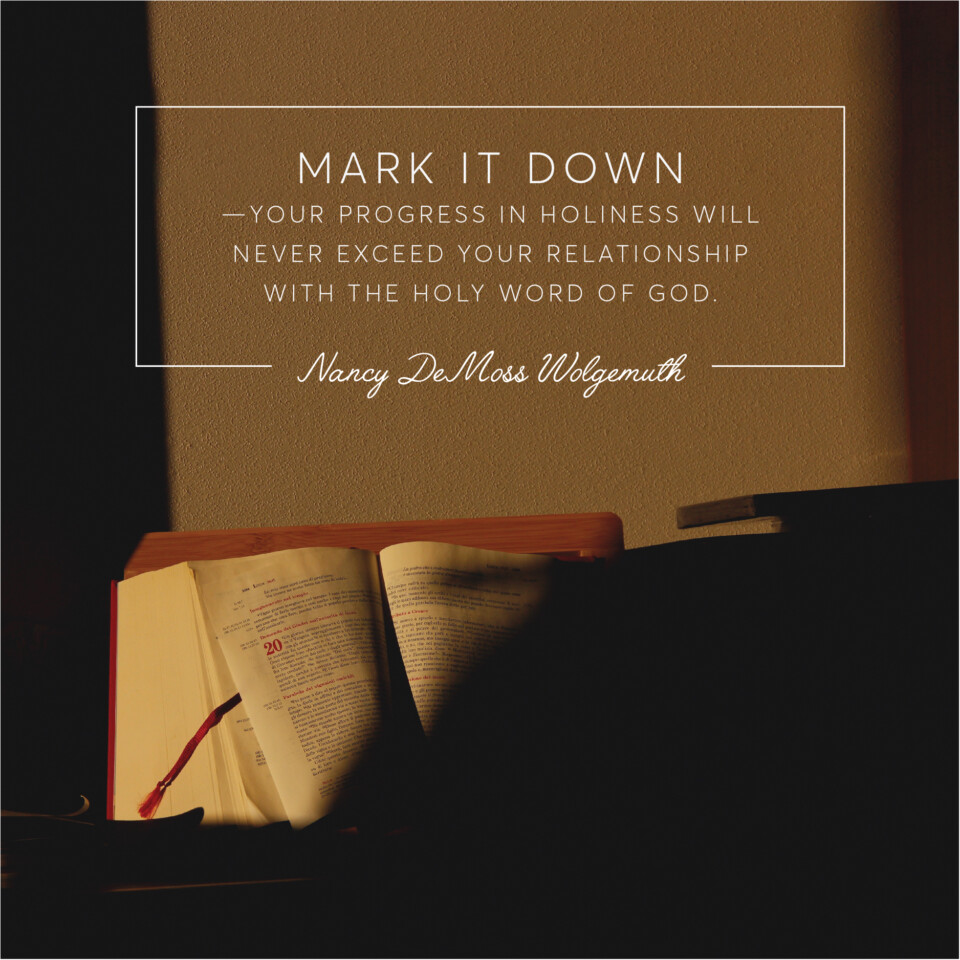
 We have entered into an age in which many people are leaving behind their printed Bibles in favor of digital equivalents. Any new technology introduces both benefits and drawbacks, and while there are many wonderful features that come with our digital Bibles, there is this downside: Our Bibles are no longer a visible demonstration of our commitment to God's Word. ]]>
We have entered into an age in which many people are leaving behind their printed Bibles in favor of digital equivalents. Any new technology introduces both benefits and drawbacks, and while there are many wonderful features that come with our digital Bibles, there is this downside: Our Bibles are no longer a visible demonstration of our commitment to God's Word. ]]>
We have entered into an age in which many people are leaving behind their printed Bibles in favor of digital equivalents. Any new technology introduces both benefits and drawbacks, and while there are many wonderful features that come with our digital Bibles, there is this downside: Our Bibles are no longer a visible demonstration of our commitment to God’s Word.
It has long been the case that some of the holiest people own some of the most tattered Bibles. Or as someone once said in a quote that has since been attributed to any number of people, “A Bible that’s falling apart usually belongs to someone who isn’t.”
Placed on the gleaming wooden coffin of many a precious saint has been a Bible whose cover is worn, whose pages are falling out, whose margins are scrawled with lead and ink. As these people committed themselves to God’s Word day after day, as they carried their Bible to church week after week, as they read it and marked it and integrated it into their mornings and evenings, it began to show inevitable wear and tear. And as they went to be with the Lord, they left it behind as a precious artifact that attested to their love for the Lord and their long labor in his Word. As that Bible grew ever more beat-up, their soul grew ever more cleaned up.
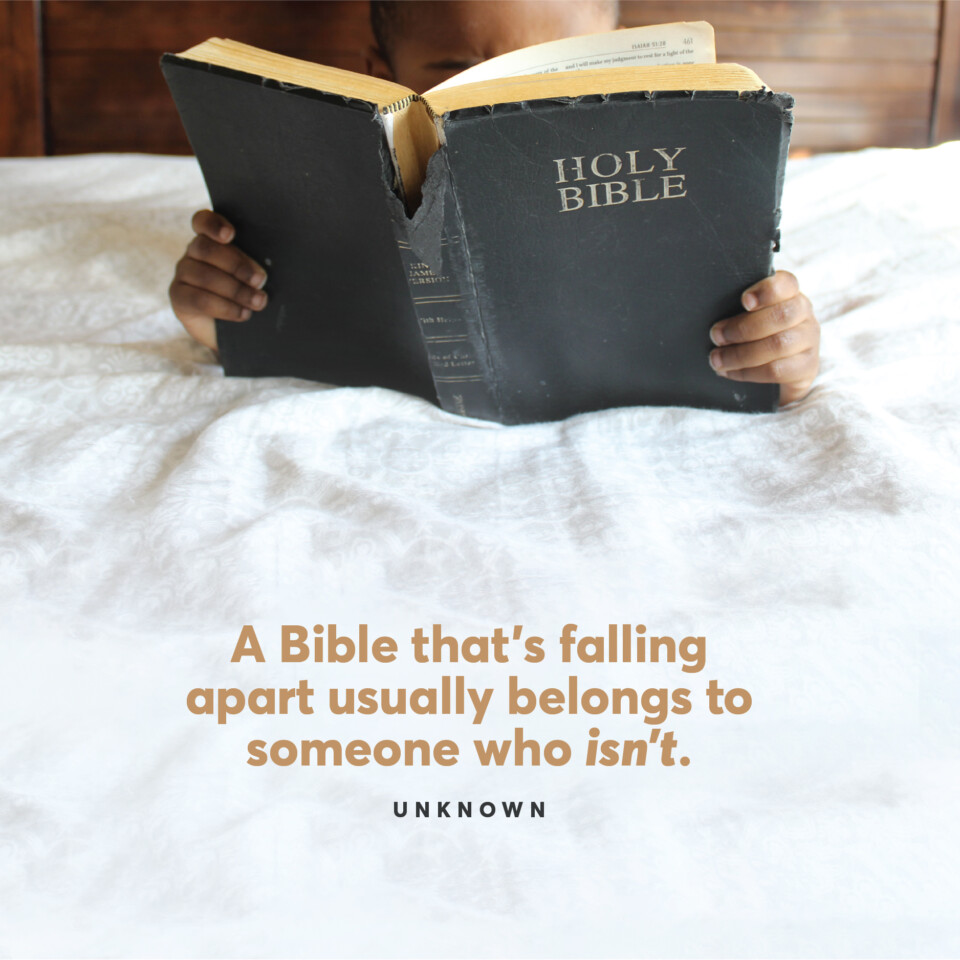
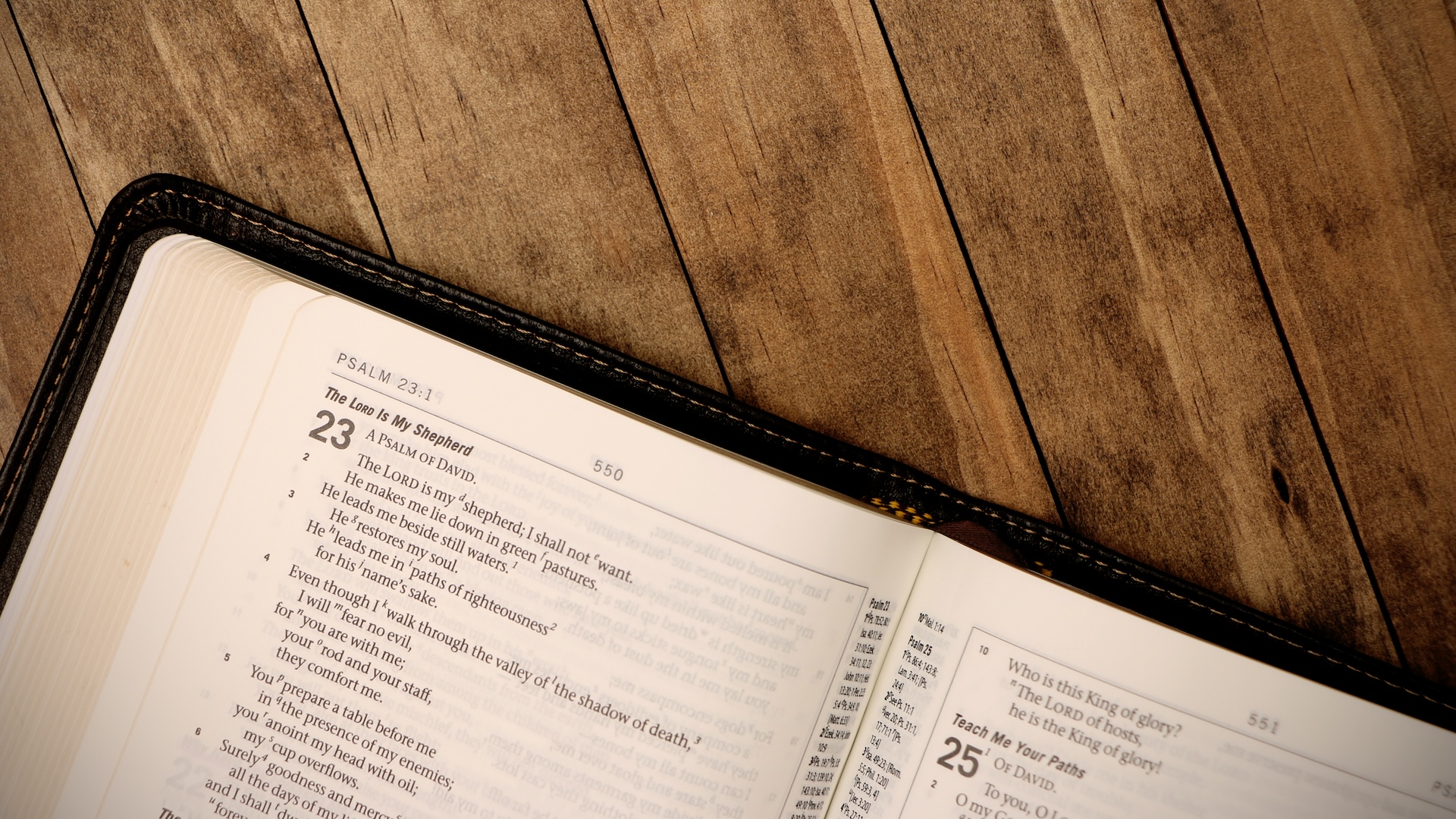 As Christians, we are unapologetic about this fact: Everything hinges on the Bible. All we believe, all we proclaim, all we do, all we hope for—it all depends on Scripture. If the Bible is not true, our faith is not true. If the Bible is not reliable, our faith is not reliable. If the Bible is not trustworthy, we are most to be pitied.]]>
As Christians, we are unapologetic about this fact: Everything hinges on the Bible. All we believe, all we proclaim, all we do, all we hope for—it all depends on Scripture. If the Bible is not true, our faith is not true. If the Bible is not reliable, our faith is not reliable. If the Bible is not trustworthy, we are most to be pitied.]]>
As Christians, we are unapologetic about this fact: Everything hinges on the Bible. All we believe, all we proclaim, all we do, all we hope for—it all depends on Scripture. If the Bible is not true, our faith is not true. If the Bible is not reliable, our faith is not reliable. If the Bible is not trustworthy, we are most to be pitied.
Little wonder, then, that the trustworthiness of Scripture is an area of constant attack and one that has generated its own category of literature. To undermine the Bible is to undermine the faith and to undermine the faith is to discourage those who hold to it. However, if the Bible can be proven to be trustworthy, then Christians can have great confidence in their Book, in their Faith, in their Savior, and in their Hope.
The trustworthiness of Scripture has been an especially important area of study to Benjamin Shaw. Shaw is an adjunct professor of theology at Liberty University and an affiliate faculty member of Colorado Christian University. Perhaps more to the point of his area of interest, he has spent more than a decade working closely with Dr. Gary Habermas who has authored or co-authored many works of apologetics. In Trustworthy: Thirteen Arguments for the Reliability of the New Testament, Shaw proves himself to be deeply indebted to Habermas and his methods and does so in a concise and reader-friendly format.
This book, he says, “is for people who want to dig deeper into the New Testament and issues regarding its reliability, whether as a disciple or as a doubter.” He goes on to say that “what I hope to accomplish … is to introduce thirteen different arguments that each point toward the reliability of the New Testament. I will be presenting these arguments as though it were the reader’s first time coming into contact with them. Hopefully, this will help the reader understand the different levels and angles at which the New Testament is trustworthy as well as give a new appreciation of the NT when reading it. Moreover, although there will always be debates—and some debates are better than others—I will try to give general arguments and conclusions in each chapter that are well-attested.”
He compares his strategy to looking at a map. He begins zoomed out with the broadest arguments. Then, as he progresses, he narrows his focus until he is zoomed in on the finer details. He begins with matters that can be established with initial confidence, then focuses more tightly on specific events and particulars. It is a helpful way of going about the task.
In the initial chapters, then, he looks at New Testament textual evidence and asks “Does our modern New Testament contain the words that were originally written? How can we know?” Next, he looks at New Testament genres and audience expectations to ask whether ancient readers were expected to understand the New Testament as historical or fanciful. He considers the dating and authorship of the various books, the earliest creedal traditions, and the criteria that can convince historians whether certain events actually took place.
As the book heads toward its final chapters, he considers whether non-canonical sources support or contradict Scripture’s claims along with the matter of canonicity. He closes with Habermas’ “minimal facts approach” which asks “Can the events central to the gospel message be confirmed even if the New Testament is unreliable in some areas? Are there historical facts related to Jesus’ death and resurrection that scholars from wide-ranging theological backgrounds agree on due to their being highly evidenced? If so, this would indicate that other arguments, such as the dozen above, have greater viability.”
In the end, Shaw offers 13 very good arguments for the reliability of the New Testament. And while each one is compelling in its own way, the impact of 13 following one after the other is tremendously encouraging and faith-building. For those who may be wondering, those who may be wavering, or even those who may be doubting, Trustworthy makes a strong case for the reliability of the New Testament.
]]> The Bible is, by its very nature, a collection—a collection of histories, biographies, letters, prophecies, and poetry written across about 1,500 years in many different settings and many different cultures. You might wonder, why these books and why not others? What binds together the sixty-six books that together make up the book is that they are the complete and authoritative collection of inspired writings—writings that came to humanity from the mind of God.]]>
The Bible is, by its very nature, a collection—a collection of histories, biographies, letters, prophecies, and poetry written across about 1,500 years in many different settings and many different cultures. You might wonder, why these books and why not others? What binds together the sixty-six books that together make up the book is that they are the complete and authoritative collection of inspired writings—writings that came to humanity from the mind of God.]]>
The Bible is, by its very nature, a collection—a collection of histories, biographies, letters, prophecies, and poetry written across about 1,500 years in many different settings and many different cultures. You might wonder, why these books and why not others? What binds together the sixty-six books that together make up the book is that they are the complete and authoritative collection of inspired writings—writings that came to humanity from the mind of God.
This being the case, we would expect there to be a kind of unity even amid all the diversity of authors, settings, contexts, and cultures. And sure enough, this is exactly what we find and exactly what Alistair Begg wants us to understand when he says, “We find Christ in all the scriptures. In the Old Testament he is predicted, in the Gospels he is revealed, in Acts he is preached, in the Epistles he is explained, and in Revelation he is expected.”
The unifying theme of the Bible is Jesus Christ (Luke 24:27). In the Old Testament writings he is predicted and longed for. In the Gospels he is revealed and described. In the book of Acts he is preached, in the epistles (letters) he is explained, and in the final book, the book of Revelation, he is expected to make his grand return. In this way, Jesus is the theme of the Bible and is present on every page.
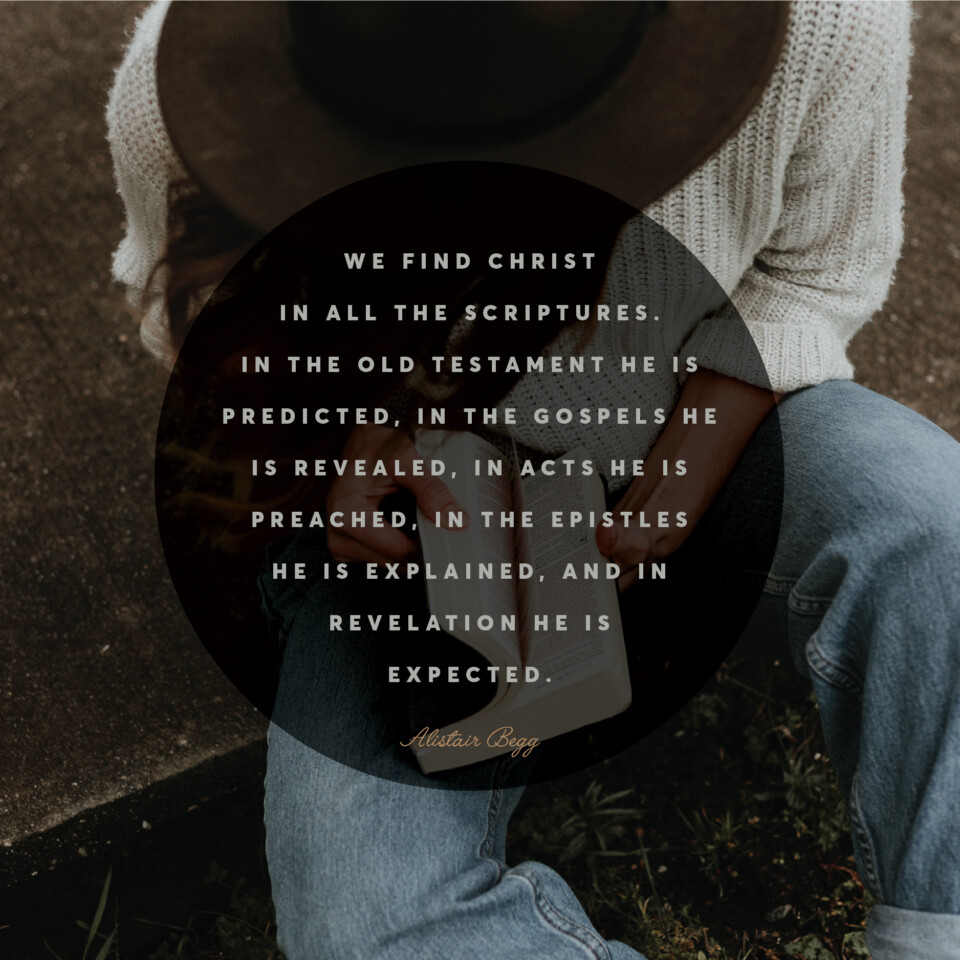
 The Bible has life and the Bible brings life because it has been spoken by God. The Bible's life, its voice, its feet, and hands are the life, voice, feet, and hands of God extended toward his people. For that reason among others it is always worthy of our time, our attention, and our dedication.]]>
The Bible has life and the Bible brings life because it has been spoken by God. The Bible's life, its voice, its feet, and hands are the life, voice, feet, and hands of God extended toward his people. For that reason among others it is always worthy of our time, our attention, and our dedication.]]>
The Bible is alive; it speaks to me. It has feet; it runs after me. It has hands; it lays hold of me!” So said Martin Luther many years ago. I wonder if you noticed that in this quote, he employs the literary technique of anthropomorphism—he applies the attributes of a person to the Bible. He declares that the Bible has qualities of life: that it has a voice and can speak, that it has feet and can run, that it has hands and can grasp.
If you have studied the life of Luther, you’ll know that in a time of great spiritual torment he committed himself to a careful study of the Bible. As he agonized over it day after day, he came to an understanding that transformed his life and, through the Protestant Reformation, transformed the world. He came to see for himself that the Bible truly is “living and abiding” (1 Peter 1:23).
And Luther was right! The Bible has life and the Bible brings life because it has been spoken by God. The Bible’s life, its voice, its feet, and hands are the life, voice, feet, and hands of God extended toward his people. For that reason among others it is always worthy of our time, our attention, and our dedication. Have you read your Bible today?
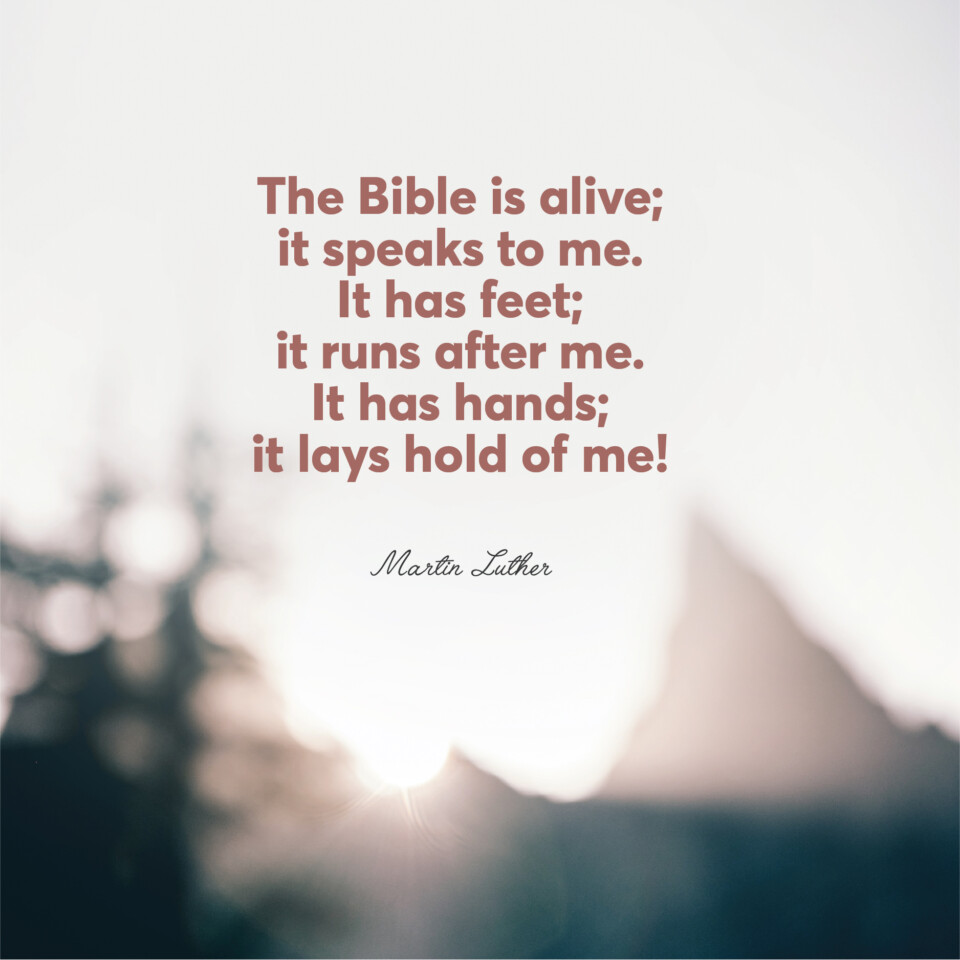
 There are two ways to read the Bible. The first way to read it is as a series of stories, books, statements, and teachings that are fragmented and disjointed, that, though they have little relationship to one another, have been compiled into an errant and fallible collection. The other way is to read it as a consistent, connected, and consecutive work that tells one cohesive story. When we read it this way…]]>
There are two ways to read the Bible. The first way to read it is as a series of stories, books, statements, and teachings that are fragmented and disjointed, that, though they have little relationship to one another, have been compiled into an errant and fallible collection. The other way is to read it as a consistent, connected, and consecutive work that tells one cohesive story. When we read it this way…]]>
There are two ways to read the Bible. The first way to read it is as a series of stories, books, statements, and teachings that are fragmented and disjointed, that, though they have little relationship to one another, have been compiled into an errant and fallible collection. The other way is to read it as a consistent, connected, and consecutive work that tells one cohesive story. When we read it this way, we see that Genesis is as connected to Revelation as it is to Exodus, that the ending perfectly complements and completes the beginning. When we accept it like this, we understand it as it truly is.
I’d love for you to read this lovely piece of writing by Theodore Cuyler who explains how we ought to read God’s Word—how we ought to read the story of how God is at work in this world to save his people and bring glory to his name. Read it and be blessed!
Some people regard the Word of God as a mere miscellaneous collection of disjointed fragments. They could not make a greater mistake. The Bible is as thoroughly connected and consecutive a work as Bunyan’s “Pilgrim,” or Bancroft’s History. The whole composition hangs together like a fleece of wool.
It begins with the creation of the world; it ends with the winding-up of all earthly things and the opening scenes of the endless hereafter. The Old Testament is the majestic vestibule through which we enter the matchless Parthenon of the New. It is mainly the history of God’s covenant people. Through all this history of nearly forty centuries are interspersed the sublime conversations of Job, the pithy proverbs of Solomon, and the predictions of the Prophets. We hear, at their proper intervals, the timbrel of Miriam, the harp of the Psalmist, the plaintive viol of Jeremiah, and the sonorous trumpets of Isaiah and Habakkuk.
Through all the Old Testament there flows one warm and mighty current—like the warm river of the Gulfstream through the Atlantic—setting towards Jesus Christ. In Genesis he appears as the seed of the woman that should bruise the serpent’s head; the smoke of Abel’s altar points towards him; the blood that stains the Jewish lintels on the night of the Exodus is but a type of the Lamb of God that taketh away the sin of the world; Moses and the prophets testify of Jesus. Just as the rich musical blast of an Alpine horn on the Wengern is echoed back from the peaks of the Jungfrau, so every verse of the fifty-third chapter of Isaiah is echoed in the New Testament of Immanuel.
After a silence of four hundred years, the New Testament begins—and with the genealogy of the incarnate Savior. The first four books are occupied with the earthly life and sacrificial death and resurrection and ascension of the same Personage. The four independent narratives of the evangelists—like the four walls of a church edifice—contain and enclose the complete narrative of Christ’s life. Each one has its place and its purpose. Matthew wrote for the Jews, and in his gospel Christ is represented as a king; the book describes his kingdom and its laws. Mark describes his wondrous deeds as the man of action—the Christ as a servant doing his Father’s will. Luke wrote for the Gentiles, and of Jesus as the Son of Man. John occupies his rich aromatic pages with the wonderful words of the Son of God. He defines his special object at the close of his twentieth chapter: “These are written that ye may believe that Jesus is the Christ, the Son of God, and that believing ye might have life through his name.”
The biographies of Jesus are completed, but not his life upon earth. The next book carries it forward. He still lives by his Spirit in the chosen Apostles. The Book of the Acts written by Luke, commences with these words—“The former treatise have I made, O Theophilus, of all that Jesus began to do and to teach.” This second treatise simply continues to narrate what Christ does and teaches through his Apostles and representatives. It is devoted to the founding of Christian churches in certain great centers of influence, like Jerusalem, Antioch, Ephesus, Corinth and Rome. The churches thus founded must next be instructed in the commandments of their Lord and be indoctrinated in the practical principles of holy living. Hence arises a necessity for the Epistles. Each has its province. The epistle to the Romans is the grand argument for justification by faith. That to the Galatians treats of deliverance from the bondage of the law. The letter to the Philippians is redolent of gratitude and of joy in hours of trouble. Its motto is “gaudeo; gaudete!” The epistle to the Ephesians is the setting forth of the “heavenlies;” that to Philemon is the charter of human rights and the seed of emancipation-proclamations; the epistles to the Corinthians are manuals for personal conduct and the government of churches. When Paul wrote to Timothy and to Titus, he furnished manuals for Christian pastors. John’s epistles are all love letters—the effusive sweetness of the heart’s honeycomb. When Apollos penned the Epistle to the Hebrews (as I am inclined to believe that he did) he set forth the priestly office of Jesus and the blessings of personal faith. Peter utters the practical precepts and warnings that are needed not only by the dispersed disciples, but by all disciples to the end of time.
When the life, the death, and the mighty works and divine instruction of Christ (by his Apostles) have been completed, there bursts upon us the magnificent panorama of the Apocalypse. This is the book of sublime mysteries. But through all the apparent confusions of thrones and of armies, of thunders and lightnings, of trumpets and viols and winged angels, we can distinctly trace the progress of the final conflict between King Jesus and the powers of darkness. The long battle terminates in the overthrow of Satan, and the glorious victory of him who wears on his head the many crowns. Then comes the final resurrection of the dead, the general Judgment, the revelation of the New Jerusalem, prepared for the endless habitation of the redeemed. The Apocalypse closes with its seven-fold chorus of hallelujahs and harping symphonies.
Such is the wondrous volume which God has given to man, and which outweighs all the libraries on the globe. It contains many writings, yet is it but one book. It has many writers, yet it is all from one Author, the Almighty Spirit of God. The pure, white, spotless fleece hath throughout its connecting fibers; the fabric is divine in its origin, its unity, and its imperishable power and glory.
]]>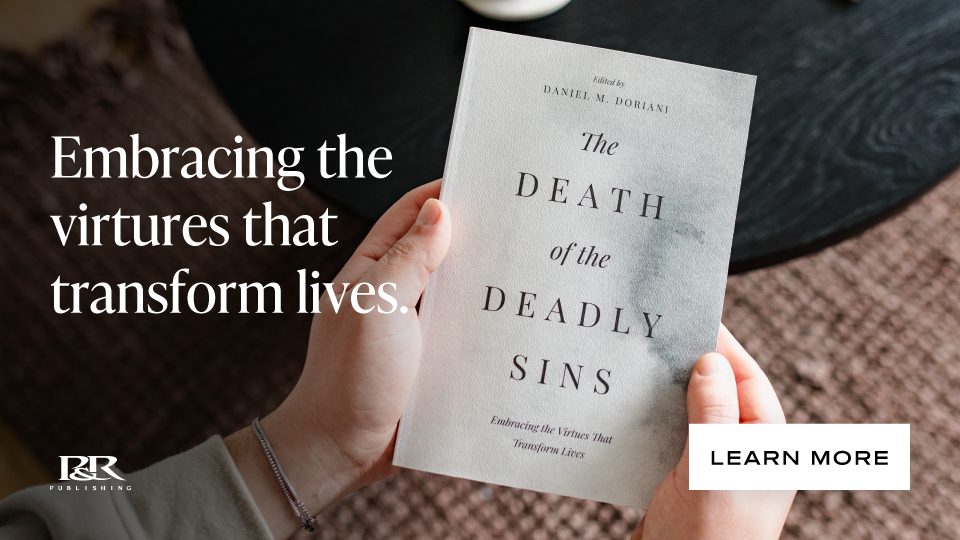 ]]>
]]>| This page is current as of December 2023. For recommendations on other books and an introduction to this series, visit Best Commentaries on Each Book of the Bible. |
Before turning to the expert recommendations, here are some recent commentaries written by trusted scholars that may be of interest. Because these volumes are newly published, the commentators on the commentaries have not yet had opportunity to evaluate them. They would, though, come with my recommendation.
- David Garland – Luke (Zondervan Exegetical Commentary on the New Testament). The ZECNT is quickly proving itself to be a premier commentary series. Garland is a trusted commentator, so I believe this volume will attract the plaudits of many scholars and pastors. (Amazon, Westminster Books, Logos)
- James R. Edwards – The Gospel According to Luke (Pillar New Testament Commentary). The Pillar series is one of the absolute best and every volume is worth collecting. This one was released after most of the commentaries on the commentaries were already published. (Amazon, Westminster Books, Logos)
And now, here are the expert recommendations:
Darrell L. Bock – Luke 1:1-9:50 & Luke 9:51-24:53 (Baker Exegetical Commentary on the New Testament). The clear and unanimous leader in the field is this 2,100-page two-volume set by Darrell Bock. It receives accolades for being thorough but not dense, for being conservative, and for having plenty of theological discussion that makes it especially useful for sermon preparation. D.A. Carson praises the volumes for being “recent, comprehensive, well written, and intelligent.” Do note that Bock has written two other volumes on Luke but that if you own these, you will not need the others. (Amazon: Volume 1 & Volume 2, Westminster Books: Volume 1 & Volume 2, Logos: Volume 1 & Volume 2)
Robert H. Stein – Luke (New American Commentary). Stein’s 642-page commentary is positively small next to Bock’s. It is considered an intermediate-level commentary that may be a little too advanced for the casual reader; the pastor or scholar well-versed in Greek may want to pass it up in favor of Bock and Marshall (see below). One benefit of this commentary is that it is reasonably-priced and thus good value for the money. (Amazon, Logos)
Leon Morris – Luke (Tyndale New Testament Commentaries). The inherent and deliberate limits of the Tyndale New Testament Commentaries means that this volume is relatively short (370 pages) and written at a popular level. This is the entry-level commentary for those who would like just one volume on Luke. Morris has written commentaries on many books of the Bible and they are uniformly sound even if they are rarely considered the top of the class. (Amazon, Logos)
Joel Green – The Gospel of Luke (New International Commentary on the New Testament). Most commentators on the commentaries commend this volume, D.A. Carson among them, though he offers caveats. He says it is “full of thoughtful interaction with contemporary scholarship, but I do not think it is either as rigorous or as accurate as the work of Luke.” He suggests that its unique strength is narrative historiography and discourse analysis. If you, like me, don’t know what that means, then perhaps choose one of the other volumes! (Amazon, Westminster Books, Logos)
Of course there are many other volumes on Luke that we could consider. Philip Ryken’s contribution to the Reformed Expository Commentary series is too new to have gained many reviews, but I always find Ryken a steady guide and a helpful expositor with his sermon-based commentaries. This two-volume set is ideal for devotional reading or for a pastor looking for a model of fine expository preaching. (Amazon, Westminster Books, Logos)
Let me close with a question: What are your preferred commentaries on Luke? Are there some you’ve found particularly helpful or are there some we would do well to avoid?
]]> Whatever history may record about the church of this era, it certainly will not record that we had a shortage of Bibles or excellent resources to help us better understand the Bible. To the contrary, there is a host of faithful Bible translations in the English language and there are far more excellent resources than any individual could possibly read. We are richly blessed. A new blessing is Crossway’s ESV Church History Study Bible which is meant to offer wisdom for the present by way of voices from the past. In other words, it offers commentary on the full text of the Bible that has been drawn from classic writers, theologians, pastors, and even poets. General editor Stephen Nichols explains in the Introduction. “Unlike in other study Bibles, the notes in the ESV Church History Study Bible have not been written by the editors. Instead, the notes have been compiled by a team of biblical scholars and church historians. The actual contributors of the notes are a varied group, stretching back from the first and second centuries and reaching forward to the twentieth century. These are theologians, pastors, poets, and laity, all offering their perspective on God’s Word. In the ESV Church History Study Bible we escape the tyranny of the present to see wisdom from the past.” And while the notes from these historical figures is the main distinguishing feature, there are also brief introductions to each of the books, sidebars on certain passages that played a role in a key moment of church…]]>
Whatever history may record about the church of this era, it certainly will not record that we had a shortage of Bibles or excellent resources to help us better understand the Bible. To the contrary, there is a host of faithful Bible translations in the English language and there are far more excellent resources than any individual could possibly read. We are richly blessed. A new blessing is Crossway’s ESV Church History Study Bible which is meant to offer wisdom for the present by way of voices from the past. In other words, it offers commentary on the full text of the Bible that has been drawn from classic writers, theologians, pastors, and even poets. General editor Stephen Nichols explains in the Introduction. “Unlike in other study Bibles, the notes in the ESV Church History Study Bible have not been written by the editors. Instead, the notes have been compiled by a team of biblical scholars and church historians. The actual contributors of the notes are a varied group, stretching back from the first and second centuries and reaching forward to the twentieth century. These are theologians, pastors, poets, and laity, all offering their perspective on God’s Word. In the ESV Church History Study Bible we escape the tyranny of the present to see wisdom from the past.” And while the notes from these historical figures is the main distinguishing feature, there are also brief introductions to each of the books, sidebars on certain passages that played a role in a key moment of church…]]>
Whatever history may record about the church of this era, it certainly will not record that we had a shortage of Bibles or excellent resources to help us better understand the Bible. To the contrary, there is a host of faithful Bible translations in the English language and there are far more excellent resources than any individual could possibly read. We are richly blessed.
A new blessing is Crossway’s ESV Church History Study Bible which is meant to offer wisdom for the present by way of voices from the past. In other words, it offers commentary on the full text of the Bible that has been drawn from classic writers, theologians, pastors, and even poets. General editor Stephen Nichols explains in the Introduction. “Unlike in other study Bibles, the notes in the ESV Church History Study Bible have not been written by the editors. Instead, the notes have been compiled by a team of biblical scholars and church historians. The actual contributors of the notes are a varied group, stretching back from the first and second centuries and reaching forward to the twentieth century. These are theologians, pastors, poets, and laity, all offering their perspective on God’s Word. In the ESV Church History Study Bible we escape the tyranny of the present to see wisdom from the past.”
And while the notes from these historical figures is the main distinguishing feature, there are also brief introductions to each of the books, sidebars on certain passages that played a role in a key moment of church history, and then a series of articles that provide an overview of church history and an explanation of some of its dominant themes.
The ESV Church History Study Bible is intended to serve pastors and students, placing a wealth of teaching, insight, and encouragement from church history alongside the biblical text and within the covers of a single volume. The ESV Church History Study Bible is also intended to serve laity by introducing them to the vast riches of church history that can encourage and edify. The ESV Church History Study Bible stands as a reminder to all of us that we are part of one body, proclaiming one gospel, reading and studying one Bible, in obedience and service to one Lord and Savior.
Edited by Stephen J. Nichols, Gerald Bray, and Keith A. Mathison, with notes compiled by nearly twenty theologians and church historians, and containing the words of hundreds of Christian figures from the past, the ESV Church History Study Bible accomplishes its purpose well. It may not replace your favorite go-to study Bible, but I’m certain you’ll find that it complements it well. This is a resource I have been anticipating with eagerness and one I expect to turn to often.
]]> Sometimes it’s simple enough to know what a book is, but a little more difficult to know what it’s meant for. Understanding a book’s contents is sometimes a bit simpler than knowing how to use it. And I’d say that’s exactly the case for A Divine Tapestry by Ryan McGraw. A Divine Tapestry is simply summaries and memory verses from every chapter of the Bible. In other words, it is divided into 66 chapters, one for each book of the Bible. Each of these is divided into as many sections as there are chapters of that biblical book, and for every one there is a summary and a suggested key verse (or, sometimes, several key verses). And that’s it—that’s the book. Simple enough. But what’s it for and how might you use it? To answer that, it would be helpful to understand its genesis. In the Introduction McGraw (who is a professor of Systematic Theology at Greenville Presbyterian Theological Seminary) explains that it began as a means to introduce children to the Bible and its big story, first by memorizing some of its most important verses, but also through brief summaries of each of its chapters. But then seminary students heard about the resource and began to ask for it as they prepared for their ordination exams. And then church members requested it so they could come to better understand the Bible. And eventually it grew into this book. So how might you use it? Most obviously, it is a useful supplement for daily Bible-reading.…]]>
Sometimes it’s simple enough to know what a book is, but a little more difficult to know what it’s meant for. Understanding a book’s contents is sometimes a bit simpler than knowing how to use it. And I’d say that’s exactly the case for A Divine Tapestry by Ryan McGraw. A Divine Tapestry is simply summaries and memory verses from every chapter of the Bible. In other words, it is divided into 66 chapters, one for each book of the Bible. Each of these is divided into as many sections as there are chapters of that biblical book, and for every one there is a summary and a suggested key verse (or, sometimes, several key verses). And that’s it—that’s the book. Simple enough. But what’s it for and how might you use it? To answer that, it would be helpful to understand its genesis. In the Introduction McGraw (who is a professor of Systematic Theology at Greenville Presbyterian Theological Seminary) explains that it began as a means to introduce children to the Bible and its big story, first by memorizing some of its most important verses, but also through brief summaries of each of its chapters. But then seminary students heard about the resource and began to ask for it as they prepared for their ordination exams. And then church members requested it so they could come to better understand the Bible. And eventually it grew into this book. So how might you use it? Most obviously, it is a useful supplement for daily Bible-reading.…]]>
Sometimes it’s simple enough to know what a book is, but a little more difficult to know what it’s meant for. Understanding a book’s contents is sometimes a bit simpler than knowing how to use it. And I’d say that’s exactly the case for A Divine Tapestry by Ryan McGraw.
A Divine Tapestry is simply summaries and memory verses from every chapter of the Bible. In other words, it is divided into 66 chapters, one for each book of the Bible. Each of these is divided into as many sections as there are chapters of that biblical book, and for every one there is a summary and a suggested key verse (or, sometimes, several key verses). And that’s it—that’s the book. Simple enough. But what’s it for and how might you use it?
To answer that, it would be helpful to understand its genesis. In the Introduction McGraw (who is a professor of Systematic Theology at Greenville Presbyterian Theological Seminary) explains that it began as a means to introduce children to the Bible and its big story, first by memorizing some of its most important verses, but also through brief summaries of each of its chapters. But then seminary students heard about the resource and began to ask for it as they prepared for their ordination exams. And then church members requested it so they could come to better understand the Bible. And eventually it grew into this book.
So how might you use it? Most obviously, it is a useful supplement for daily Bible-reading. I, for example, read several chapters of the Bible each day and have enjoyed being able to preview and get the context for what I am about to read (or, more commonly, listen to) by first reading these summaries. I can then turn to them again later in the day to remind myself of what I’ve heard and help fix them in my mind. It’s like the old teaching technique: tell them what you’re going to say, say it, and then tell them what you’ve said.
Here’s how the author suggests you put it to use:
The best way to use this book is to have it open while reading through the whole Bible. Each chapter can encourage readers to keep going as the summaries and memory verse train them what to look for and how to read better. Reading through the Bible in families, with this book as a companion and guide, can also help parents pass along what they learn to their children. Older children and students can work through it themselves.
Opening the book at random, I find myself in the middle chapters of Ezekiel and this is what I see:
Chapter 26
The Lord Proclaims Judgment Against Tyre as a Paradigm for His Judgments Against All Nations
‘Son of man, because Tyre has said against Jerusalem, “Aha! She is broken who was the gateway of the peoples; now she is turned over to me; I shall be filled; she is laid waste.”’ Ezek. 26:2
Chapter 27
The Prophet Takes Up a Lamentation for Tyre, Showing the Desolation of the Nations
’All the inhabitants of the isles will be astonished at you; Their kings will be greatly afraid, and their countenance will be troubled. The merchants among the peoples will hiss at you; You will become a horror, and be no more forever.’ Ezek. 27:35-36
Chapter 28
The King of Tyre, Who Exalted himself as a god, Will Die the Death of the Uncircumcised, Sidon Will Share in her Judgment, and God Will Restore Israel
‘Thus says the Lord God: “When I have gathered the house of Israel from the peoples among whom they are scattered, and am hallowed in them in the sight of the Gentiles, then they will dwell in their own land which I gave to My servant Jacob. And they will dwell safely there, build houses, and plant vineyards; yes, they will dwell securely, when I execute judgments on all those around them who despise them. Then they shall know that I am the Lord their God.”’
That’s just the smallest sampling of the content and format.
If there is likely to be a common critique of the book, it is one the author anticipates in the Introduction: the use of the NKJV. I will not summarize his defense except to say he believes its consistency with the KJV represents a more faithful translation and that using a derivative of the KJV provokes clearer connections to the historical creeds, confessions, and catechisms. Either way, it does not significantly detract from the book.
And so A Divine Tapestry is a book that demands just a bit of explanation. But once you understand what it’s all about, you can’t help but be impressed both by its scope (a summary of every chapter of the Bible) and its usefulness (a guide to better reading the Bible). If you buy it and use it I think you’ll agree that it’s a wonderful resource.
]]>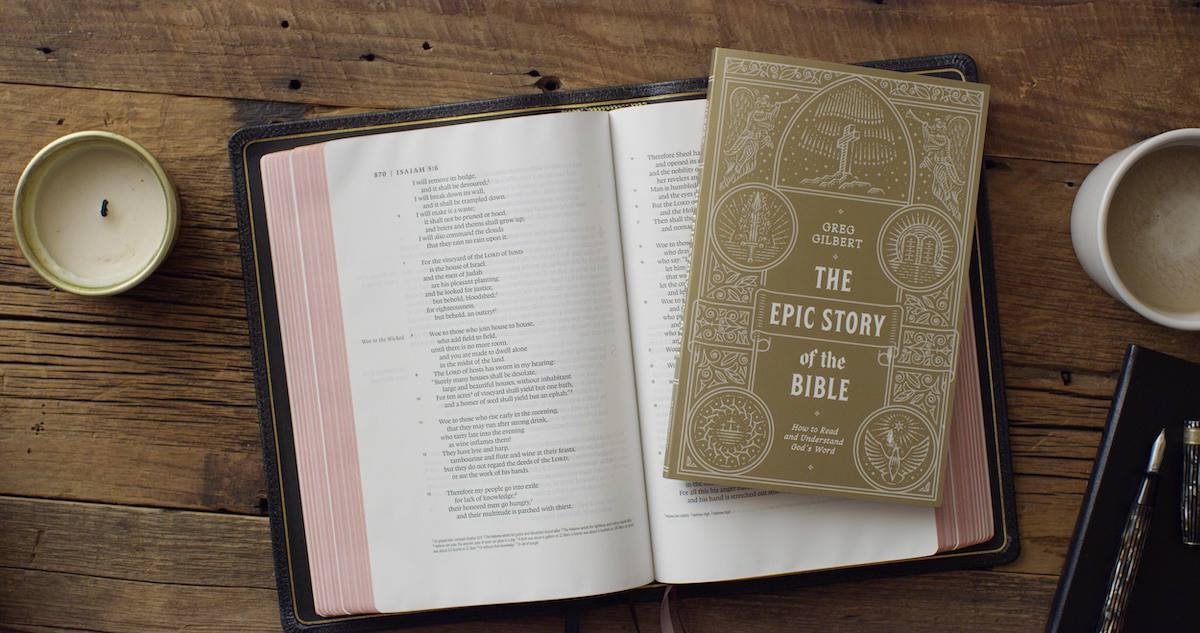 The Bible can be an intimidating book. I suppose any book of the Bible’s size can be intimidating merely by virtue of its page count. But then there’s also the claims people make about the Bible—that it’s a book that transforms lives, that it’s a book that reveals the mind of God himself, that it’s a book that is without error. And beyond that, there’s the nature of the Bible as a collection of writings that span centuries, peoples, cultures, and genres, not to mention the outsized importance of the Bible in shaping the Western world as we know it. For these reasons and many others, the Bible can intimidate people to such a degree that they read it without confidence or perhaps fail to read it at all. It’s little wonder than that Christians have often written books meant to help introduce people to the practice of reading the Bible and to help them read it profitably and in its entirety. New among them is The Epic Story of the Bible: How to Read and Understand God’s Word by Greg Gilbert. Using his own trek to Mount Everest (base camp, not summit) as a backdrop and illustration, Gilbert says his book is meant to “give you a briefing about what you’re going to see, what you’re going to experience, what you should look for and look out for as you set off on the long trek of reading the entire Bible.” The key to reading the Bible well, he says, “is to understand that…]]>
The Bible can be an intimidating book. I suppose any book of the Bible’s size can be intimidating merely by virtue of its page count. But then there’s also the claims people make about the Bible—that it’s a book that transforms lives, that it’s a book that reveals the mind of God himself, that it’s a book that is without error. And beyond that, there’s the nature of the Bible as a collection of writings that span centuries, peoples, cultures, and genres, not to mention the outsized importance of the Bible in shaping the Western world as we know it. For these reasons and many others, the Bible can intimidate people to such a degree that they read it without confidence or perhaps fail to read it at all. It’s little wonder than that Christians have often written books meant to help introduce people to the practice of reading the Bible and to help them read it profitably and in its entirety. New among them is The Epic Story of the Bible: How to Read and Understand God’s Word by Greg Gilbert. Using his own trek to Mount Everest (base camp, not summit) as a backdrop and illustration, Gilbert says his book is meant to “give you a briefing about what you’re going to see, what you’re going to experience, what you should look for and look out for as you set off on the long trek of reading the entire Bible.” The key to reading the Bible well, he says, “is to understand that…]]>
The Bible can be an intimidating book. I suppose any book of the Bible’s size can be intimidating merely by virtue of its page count. But then there’s also the claims people make about the Bible—that it’s a book that transforms lives, that it’s a book that reveals the mind of God himself, that it’s a book that is without error. And beyond that, there’s the nature of the Bible as a collection of writings that span centuries, peoples, cultures, and genres, not to mention the outsized importance of the Bible in shaping the Western world as we know it. For these reasons and many others, the Bible can intimidate people to such a degree that they read it without confidence or perhaps fail to read it at all.
It’s little wonder than that Christians have often written books meant to help introduce people to the practice of reading the Bible and to help them read it profitably and in its entirety. New among them is The Epic Story of the Bible: How to Read and Understand God’s Word by Greg Gilbert. Using his own trek to Mount Everest (base camp, not summit) as a backdrop and illustration, Gilbert says his book is meant to “give you a briefing about what you’re going to see, what you’re going to experience, what you should look for and look out for as you set off on the long trek of reading the entire Bible.”
The key to reading the Bible well, he says, “is to understand that all of those authors and books—all 1,189 chapters of them—are actually working together to tell one overarching, mind-blowing story about God’s action to save human beings from their high-handed rebellion against him, and from the effects and consequences of that rebellion.”
That story is nothing short of epic as he illustrates in this very brief overview: “Wars between angels rage in the spiritual realm, while on earth kingdoms rise and fall, empires clash, cities are built and destroyed, priests perform sacrifices, and prophets point their bony fingers to the future. And in the end, a great throne is toppled and a great crown falls to the ground, only to be given finally to one thirty-year-old man—a subjugated peasant from a conquered nation—whom God enthrones over the entire world as the one who alone can and does offer mercy to rebels. If there’s ever been an epic story told in the history of mankind, this one is it!”
A story so epic is certainly worth reading and Gilbert means to help by introducing his readers to some of the things they will encounter and come up against as they attempt to do so. He begins with a description of what the Bible is and where it came from. From there he traces its grand storyline in a way that may be at least somewhat familiar to those who have read Graeme Goldsworthy—an author whose work on this subject Gilbert much admires.
Having done this, he turns to some of the major themes readers will encounter as they make their trek from Genesis to Revelation, which is to say, he introduces some biblical theology, a practice that “tries to see how different truths sit and develop as the storyline of the Bible unfolds.” In other words, rather than systematically studying what the whole Bible says about a theme, it studies how a theme develops from beginning to end and how it helps propel the narrative forward. Thus over four chapters he traces the theme of God’s presence, the theme of covenant, the theme of kingship, and the theme of sacrifice. The final chapter, “Setting Out,” offers a number of tips and practices that will assist people to make the journey well and to take it all the way to completion.
It is an unfortunate fact that many Christians have read parts of the Bible, but have never read the whole Bible. They have read parts of the narrative, but never followed it all the way through. They don’t know what they are missing! The Epic Story of the Bible is meant to help them not only learn what they are missing but also help them to set out and complete that epic, beautiful, and rewarding trek. And I am convinced it will serve well in accomplishing that very purpose. I highly recommend reading it—and highly recommend buying a few extra copies to give away to others so they, too, can embark on a life-changing journey.
]]>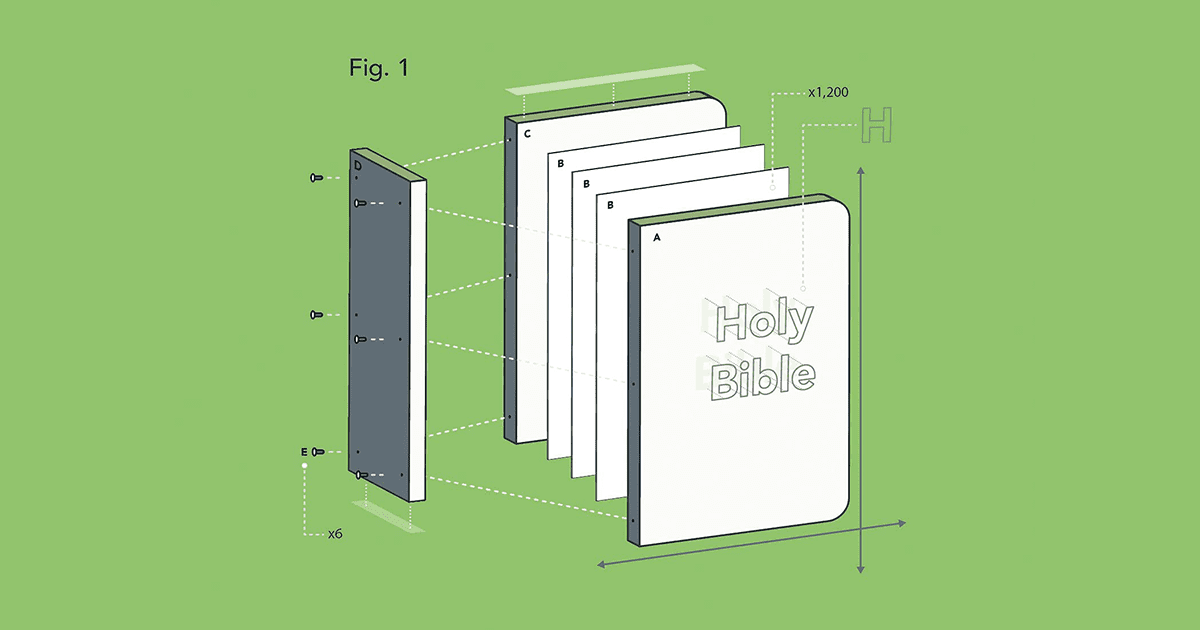 Every generation of Christians faces the very same challenge: To learn the Bible for themselves and to teach it to those who follow in their footsteps. This task cannot be willed, it cannot be inherited, it cannot be passed down. Rather, each generation must accept afresh the challenge to honor, to know, and to obey the Word of God. Gary Millar’s Read This First is, according to the subtitle, “A Simple Guide to Getting the Most from the Bible.” It is, in that way, a wonderful place to begin for those who wish to accept their God-given responsibility (or alternatively, a wonderful resource to distribute to help others with theirs). Millar says, “This book aims to help people who would like to read the Bible but don’t really know where to start or how to go about it. You may be a Christian who enjoys being part of a church or a Bible-study group, but you end up feeling lost and confused whenever you attempt to read the Bible for yourself. You may have even tried to embark on a Bible-reading regime but … it didn’t take long before you gave up with a sense of defeat: you just don’t get it. That’s why I’ve written this book: to guide you through it. My hope is that you’ll read this first and go back to the Bible with the skills and confidence to truly enjoy it.” There is a second audience in his mind: “You may be pretty new to Christianity. You have always thought…]]>
Every generation of Christians faces the very same challenge: To learn the Bible for themselves and to teach it to those who follow in their footsteps. This task cannot be willed, it cannot be inherited, it cannot be passed down. Rather, each generation must accept afresh the challenge to honor, to know, and to obey the Word of God. Gary Millar’s Read This First is, according to the subtitle, “A Simple Guide to Getting the Most from the Bible.” It is, in that way, a wonderful place to begin for those who wish to accept their God-given responsibility (or alternatively, a wonderful resource to distribute to help others with theirs). Millar says, “This book aims to help people who would like to read the Bible but don’t really know where to start or how to go about it. You may be a Christian who enjoys being part of a church or a Bible-study group, but you end up feeling lost and confused whenever you attempt to read the Bible for yourself. You may have even tried to embark on a Bible-reading regime but … it didn’t take long before you gave up with a sense of defeat: you just don’t get it. That’s why I’ve written this book: to guide you through it. My hope is that you’ll read this first and go back to the Bible with the skills and confidence to truly enjoy it.” There is a second audience in his mind: “You may be pretty new to Christianity. You have always thought…]]>
Every generation of Christians faces the very same challenge: To learn the Bible for themselves and to teach it to those who follow in their footsteps. This task cannot be willed, it cannot be inherited, it cannot be passed down. Rather, each generation must accept afresh the challenge to honor, to know, and to obey the Word of God.
Gary Millar’s Read This First is, according to the subtitle, “A Simple Guide to Getting the Most from the Bible.” It is, in that way, a wonderful place to begin for those who wish to accept their God-given responsibility (or alternatively, a wonderful resource to distribute to help others with theirs).
Millar says, “This book aims to help people who would like to read the Bible but don’t really know where to start or how to go about it. You may be a Christian who enjoys being part of a church or a Bible-study group, but you end up feeling lost and confused whenever you attempt to read the Bible for yourself. You may have even tried to embark on a Bible-reading regime but … it didn’t take long before you gave up with a sense of defeat: you just don’t get it. That’s why I’ve written this book: to guide you through it. My hope is that you’ll read this first and go back to the Bible with the skills and confidence to truly enjoy it.”
There is a second audience in his mind: “You may be pretty new to Christianity. You have always thought that the Bible seems interesting enough for you to take a look, but you’ve been put off by the small print, strange ‘religious’ language, its distance from your culture, or even just its size. You may have been been encouraged to read the Bible by a friend, or heard a snippet of what it says at a wedding or funeral, or come across a quotation somewhere. It’s often said that the Bible is one of the best-selling books of all time. That alone seems like a good reason to dip into it.”
For either of those audiences, or even more experienced Bible-readers who are just looking for a bit of a refresh, Read This First offers a simple, helpful guide to reading the Bible well. It begins with an explanation of why everyone should consider reading the Bible, then begins to teach how to read it: to pay attention to the “vibe” of any passage, to discern meaning, to account for context, and to read it both as a book that was written in a different time and to a different audience and as a book that was written for we who live here and now.
Though Read This First is short and simple, that is exactly its purpose and its exactly its charm. It is just the kind of book each of us would have benefitted to read at the start of our journey to better understand God’s Word and just the kind of resource each of us loves to distribute to others. It will do exactly what it promises: help those who have a desire to read the Bible to actually read the Bible—and to read it right. I’m very glad to recommend it.
]]> Speaking broadly, there are two approaches to daily Bible-reading: reading for intimacy or reading for familiarity. Intimacy with the Bible comes by slow, meditative reading that focuses on small portions—deep study of books, chapters, and verses. Familiarity with the Bible comes through faster reading of larger portions—the entire sweep of the biblical narrative. Both are perfectly good approaches to the Bible and Christians thrive on a healthy mixture of the two. There is great benefit in knowing the Bible as a whole (familiarity) and in knowing the most important parts in detail (intimacy). (On this note, see my article “Intimacy or Familiarity.”) My favorite daily Bible-reading plan is the 5 Day Bible Reading Program. I have successfully used it for many years and intend to use it again in 2022. I gladly commend it to you. It has several features I especially appreciate: The 5 Day Bible Reading Program is a free download and will be available on December 26 (with Patrons able to get it before then). I echo their hope for the program: “God’s blessings rest with those who will read, understand, and live by His Word. May this guide help you to that noble end. ‘Thy word is a lamp to my feet, and a light to my path’ (Psalms 119:105).” (Parenthetical Note: If you prefer an “intimacy” plan, I recommend the Reading the Bible with John Stott guides and/or the God’s Word for You series. Both are excellent.)]]>
Speaking broadly, there are two approaches to daily Bible-reading: reading for intimacy or reading for familiarity. Intimacy with the Bible comes by slow, meditative reading that focuses on small portions—deep study of books, chapters, and verses. Familiarity with the Bible comes through faster reading of larger portions—the entire sweep of the biblical narrative. Both are perfectly good approaches to the Bible and Christians thrive on a healthy mixture of the two. There is great benefit in knowing the Bible as a whole (familiarity) and in knowing the most important parts in detail (intimacy). (On this note, see my article “Intimacy or Familiarity.”) My favorite daily Bible-reading plan is the 5 Day Bible Reading Program. I have successfully used it for many years and intend to use it again in 2022. I gladly commend it to you. It has several features I especially appreciate: The 5 Day Bible Reading Program is a free download and will be available on December 26 (with Patrons able to get it before then). I echo their hope for the program: “God’s blessings rest with those who will read, understand, and live by His Word. May this guide help you to that noble end. ‘Thy word is a lamp to my feet, and a light to my path’ (Psalms 119:105).” (Parenthetical Note: If you prefer an “intimacy” plan, I recommend the Reading the Bible with John Stott guides and/or the God’s Word for You series. Both are excellent.)]]>
Speaking broadly, there are two approaches to daily Bible-reading: reading for intimacy or reading for familiarity. Intimacy with the Bible comes by slow, meditative reading that focuses on small portions—deep study of books, chapters, and verses. Familiarity with the Bible comes through faster reading of larger portions—the entire sweep of the biblical narrative. Both are perfectly good approaches to the Bible and Christians thrive on a healthy mixture of the two. There is great benefit in knowing the Bible as a whole (familiarity) and in knowing the most important parts in detail (intimacy). (On this note, see my article “Intimacy or Familiarity.”)
My favorite daily Bible-reading plan is the 5 Day Bible Reading Program. I have successfully used it for many years and intend to use it again in 2022. I gladly commend it to you.
It has several features I especially appreciate:
- It is a familiarity plan that covers the entire text of the Bible over the course of the year. Those who follow it will read every word of the Bible in the year ahead.
- It is a pseudo-chronological plan that covers the text of the Bible in the order the events happened (with the exception of Job which comes at the end). Thus, for example, the Psalms come at appropriate moments in the life of David, the books of Kings and Chronicles are read in harmony, and so on. This helps set the events in their historical context. Yet even though it’s chronological, it’s only pseudo-chronological. There are Old Testament and New Testament readings each day and the gospels are interspersed through the year. I find this an ideal compromise over a strictly chronological program in which you read the entire OT before touching the NT.
- It is a 5-day plan. A benefit of a 5-day plan (as opposed to a 7-day plan) is that there is less chance of falling far behind. At 5 days per week it is far more doable than at 7 days—there is always a chance to catch up. Also, it allows a day or two of reading something different for those who, for example, like to read and ponder the sermon text on a Sunday morning or for those who don’t do personal devotions on Sunday.
- It is a free plan. It’s free for the taking! They’ve got a nice little print-out you can download, print, fold in half, and put inside your Bible. It’s got boxes to tick as you complete each day and each week. Or you can use the ReadingPlan app to organize the plan even while reading through Logos, the ESV app, or a printed Bible. Though it is free, they have launched a Patreon account for those who would like early access, access to more features, or who would just like to offer a bit of support.
The 5 Day Bible Reading Program is a free download and will be available on December 26 (with Patrons able to get it before then). I echo their hope for the program: “God’s blessings rest with those who will read, understand, and live by His Word. May this guide help you to that noble end. ‘Thy word is a lamp to my feet, and a light to my path’ (Psalms 119:105).”
(Parenthetical Note: If you prefer an “intimacy” plan, I recommend the Reading the Bible with John Stott guides and/or the God’s Word for You series. Both are excellent.)
